This article was published in Scientific American’s former blog network and reflects the views of the author, not necessarily those of Scientific American
One of the world’s most unusual and archaic rodents is the Mountain beaver, Boomer or Sewellel, a chunky-bodied, short-limbed rodent of the North American Pacific Northwest, known to scientists as Aplodontia rufa. It’s not really associated with mountains, nor is it a beaver. Typically reaching 35 cm (the tail is tiny, just 1-4 cm long), Aplodontia uses its stout limbs and broad, prominently clawed hands and feet to dig tunnels, and its small eyes and external ears and body shape are all consistent with this lifestyle. In the skeleton, the muscle attachment sites on the limb bones are large, and the prong that forms the elbow region – properly called the ulnar olecranon – is massive, meaning that the muscles that pull the hand downwards during digging are especially big. Similar features in fossil relatives of Aplodontia show that they were good diggers too. Despite these specialisations for digging, Aplodontia can swim well and even climb trees when it has to.
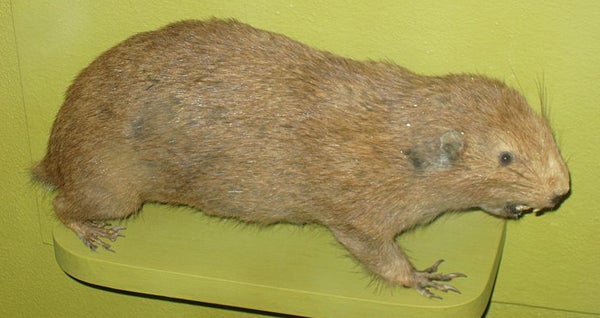
There are hardly any images of Aplodontia online that are marked with a CC license, thanks internet. Here's a stuffed specimen. Credit: Daderot Wikimedia(CC BY-SA 3.0)
Aplodontia has tall, constantly growing cheek teeth that have a simple look compared to those of many other rodents. Indeed, the name Aplodontia means ‘simple tooth’. Teeth of this sort are suited for a diet that includes bark and twigs as well as fern fronds, shoots and leaves. Many related fossil species were different from Aplodontia, with shorter teeth less able to cope with severe abrasion. The internal ear anatomy of Aplodontia is unusual compared to that of other rodents, and the part of the brain associated with the nerves that come from the ear is unusually large. Thanks to these features, it seems that Aplodontia is especially good at detecting air pressure changes within its burrows. It remains unknown as to what sort of evolutionary advantage this might provide but it could possibly serve to detect invaders or predators.
On supporting science journalism
If you're enjoying this article, consider supporting our award-winning journalism by subscribing. By purchasing a subscription you are helping to ensure the future of impactful stories about the discoveries and ideas shaping our world today.
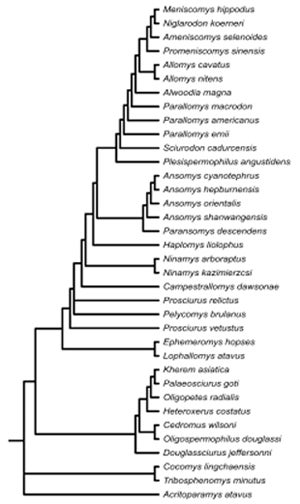
I include this cladogram (from Vianey-Liaud et al. 2013) to give you some idea of how many extinct aplodontoid taxa there are, and of course this tree doesn't show all of them. Credit: Vianey-Liaud et al. 2013
As is so often the case with modern animals, Aplodontia is merely the only living member of a once large and diverse group of rodents (Aplodontoidea), the fossil record of which extends back more than 40 million years. Termed aplodonts or aplodontoids, they were present in Europe (extinct European taxa include Ephemeromys of the Oligocene and Sciurodon of the Oligocene and Miocene) and Asia (extinct Asian taxa include Promenicomys of the Oligocene and Ansomys and Tschalimys of the Miocene) before moving across the Bering land Bridge and diversifying in North America (Flynn & Jacobs 2007, Vianey-Liaud et al. 2013). Specialists have named several subdivisions within the group (I’m avoiding the whole debate over prosciurines here) and taxa have, at times, been moved in and out of Aplodontidae, the clade that includes Aplodontia and its closest kin. Incidentally, that weird common name that no-one seems to know quite how to pronounce – Sewellel – is honoured in Sewelleladon, an Oligocene North American aplodont named in 1958.
How aplodonts are related to other rodents has been controversial, partly because they lack the complex jaw-closing muscles present in other living rodent groups. For this reason it has sometimes been assumed that aplodonts belong to an unusual side-branch that evolved directly from Ischyromys-like rodents early on in rodent history. The fact that Aplodontia lacks the specialised jaw-closing muscle arrangement typical of modern rodents (it has the so-called protrogomorphous condition) means that it has often been regarded as a ‘living fossil’: that is, as a late-surviving member of a group of animals that are otherwise from a long time ago. Such views are often somewhat misleading. Aplodontia is not especially old, its fossil record only going back a few million years.
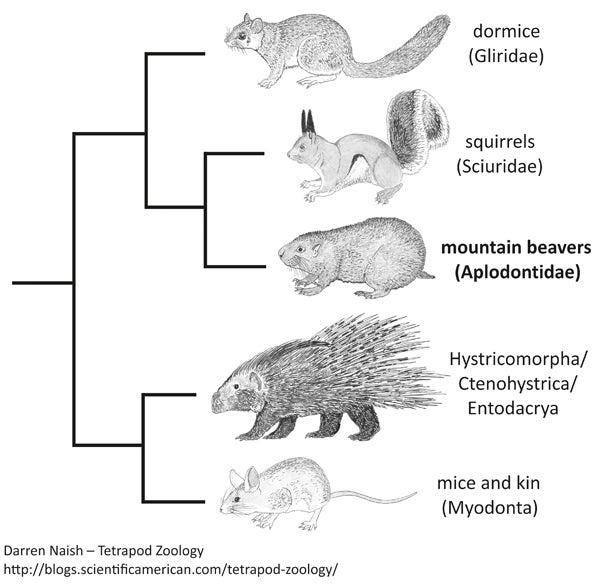
Substantially simplified depiction of rodent phylogeny, depicting the molecular tree published by Fabre et al. (2012) and showing aplodontids as close to squirrels. Illustrations from my in-prep textbook. Credit: Darren Naish
Furthermore, aplodonts resemble squirrels in the shape of their tooth cusps, so the idea that they might have evolved from the same common ancestor that gave rise to squirrels has also been suggested. This view receives support from studies of the ear region (Meng 1990) and from molecular data: both indicate that dormice, aplodonts and squirrels are close relatives and form a group that diverged from other rodents over 50 million years ago (Fabre et al. 2012).
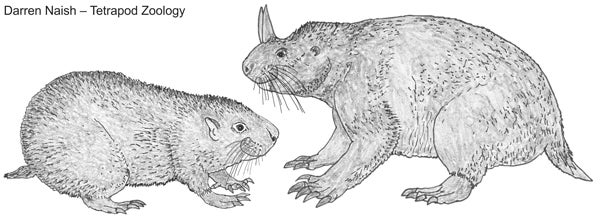
A Mountain beaver (at left) and one of its many extinct kin, the mylagaulid 'horned gopher' Ceratogaulus. Illustrations from the in-prep textbook. Credit: Darren Naish
Aplodonts share several anatomical features with an unusual group of extinct rodents that were evidently specialised for a digging lifestyle. These are the mylagaulids – sometimes known as ‘horned gophers’ – and especially remarkable for the short paired horns some species possess on their snouts. Features of the skull and neck indicate that mylagaulids used their short, tough snouts during digging, and one suggested explanation for the evolution of the horns is that they played an important role in helping to dislodge sediment. While I just implied that mylagaulids are related to aplodonts, they’re actually deeply nested within the group, and may in fact be nested within Aplodontidae. That’s a complex subject I’ll have to cover some other time.
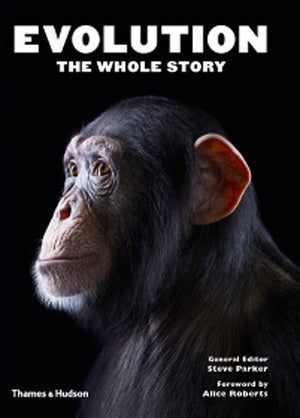
The text here is mostly from Parker (2015). Credit: Parker 2015
This text – a brief introduction to this particular rodent group – is a somewhat adapted and expanded version of the Mountain beaver section I compiled for Evolution: The Whole Story (Parker 2015), a volume I contributed to and have written about (albeit briefly) here in the past (numerous other authors contributed too, so I don’t count it as one of ‘my’ books). A longer and more technical discussion of aplodontoids and their history has of course been compiled for my The Vertebrate Fossil Record, but I don’t want to share that here.
For previous Tet Zoo articles on rodents, see...
Refs - -
Flynn, L. J. & Jacobs, L. L. 2007. Aplodontoidea. In Janis, C. M., Gunnell, G. F. & Uhen, M. D. (eds) Evolution of Tertiary Mammals of North America, Volume 2: Small Mammals, Xenarthrans, and Marine Mammals. Cambridge University Press, Cambridge, pp. 377-390.
Meng, J. 1990. The auditory region of Reithroparamys delicatissimus (Mammalia, Rodentia) and its systematic implications. American Museum Novitates 2972, 1-35.
Parker, S. 2015. Evolution: The Whole Story. Thames & Hudson, London.